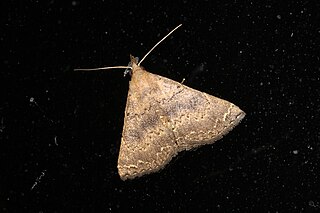Related Research Articles

Claterna is a monotypic moth genus of the family Noctuidae erected by Francis Walker in 1858. Its only species, Claterna cydonia, was first described by Pieter Cramer in 1775.

Bamra albicola is a moth of the family Noctuidae first described by Francis Walker in 1858.
Bamra mundata is a moth of the family Noctuidae first described by Francis Walker in 1858. It is found in India and Sri Lanka, Caterpillars are known to feed on Albizia and Arachis hypogaea.
Belciana biformis is a moth of the family Noctuidae first described by Francis Walker in 1858.
Brana is a monotypic moth genus of the family Noctuidae. Its only species, Brana calopasa, is found in Sri Lanka and Australia. Both the genus and species were described by Francis Walker, the genus in 1858 and the species in 1859. It It is a serious pest on Berrya cordifolia.

Caduca albopunctata is a moth of the family Noctuidae first described by Francis Walker in 1857.

Diomea rotundata is a moth of the family Noctuidae first described by Francis Walker in 1857. It is found in Sri Lanka, the Indian subregion, Taiwan, Sumatra, Borneo, the Philippines and Sumba.

Rhesala imparata is a moth of the family Erebidae first described by Francis Walker in 1865. It is sometimes referred to as an Albizia defoliator. It is found in Sri Lanka, India, Taiwan, Singapore and Borneo.

Anomis mesogona is a moth of the family Erebidae first described by Francis Walker in 1857. It is found in India, Sri Lanka, Somalia and Japan.

Aegilia describens is a moth of the family Noctuidae first described by Francis Walker in 1858. It is found in Oriental tropics of India, Sri Lanka, to New Guinea, the Bismarck Islands and Queensland, also on Christmas Islands in the Indian Ocean.

Callyna monoleuca is a moth of the family Noctuidae first described by Francis Walker in 1858. It is found in Sri Lanka, India, China, Japan, Taiwan, Myanmar, Indonesia, New Guinea and Australia.
Ancara obliterans is a moth of the family Noctuidae first described by Francis Walker in 1858. It is found in Sri Lanka, India, Malaysia, Sumatra and Borneo.
Avitta ophiusalis is a moth of the family Noctuidae first described by Francis Walker in 1859. It is found in Indian subregion, Sri Lanka, China, Japan, Sundaland, Sulawesi, Queensland, Solomon Islands, Vanuatu, Fiji and New Caledonia.
Chrysodeixis permissa is a moth of the family Noctuidae first described by Francis Walker in 1858. It is found in India, Sri Lanka, and the Maldives.
Adrapsa geometroides is a moth of the family Noctuidae first described by Francis Walker in 1858. It is found in Indian subregion, Sri Lanka. to Sundaland and New Guinea.
Hadennia jutalis is a moth of the family Noctuidae first described by Francis Walker in 1859. It is found in India, Sri Lanka, Thailand, Malaysia, Laos, Vietnam, Myanmar and the Andaman Islands.

Hipoepa biasalis is a moth of the family Noctuidae first described by Francis Walker in 1859. It is found in Oriental tropics of India and Sri Lanka to Taiwan, Sumatra, Borneo, the Philippines and Sulawesi.

Progonia oileusalis is a moth of the family Noctuidae first described by Francis Walker in 1859. It is found in Sri Lanka, Borneo, India, Taiwan, Japan and the Philippines.
Chasmina fasciculosa is a moth of the family Noctuidae first described by Francis Walker in 1858. It is found in Sri Lanka, Hong Kong, the Philippines and China.
Corgatha zonalis is a moth of the family Erebidae first described by Francis Walker in 1859. It is found in Oriental tropics of India and from Sri Lanka to Borneo, the Philippines and Japan.
References
- ↑ "Species Details: Scriptoplusia nigriluna Walker, 1857". Catalogue of Life. Retrieved 29 May 2018.
- ↑ Koçak, Ahmet Ömer; Kemal, Muhabbet (20 February 2012). "Preliminary list of the Lepidoptera of Sri Lanka". Cesa News. Centre for Entomological Studies Ankara (79): 1–57 – via Academia.
- ↑ "クロガネキンウワバ Scriptoplusia nigriluna (Walker, [1858])". Digital Moths of Japan. Retrieved 28 March 2018.
- ↑ Savela, Markku. "Scriptoplusia nigriluna (Walker, [1858])". Lepidoptera and Some Other Life Forms. Retrieved 15 October 2018.